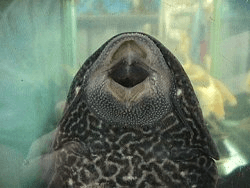
What’s a Plecostomus and how is a Plecostomus useful? (Algae)
Name
Plecostomus
Introduction:
This dark, suckermouthed scavenger is a useful additon to almost any aquaria whether it’s a cooler tropical tank or a giant cichlid tank. The Pleco’s interminable algae grazing is appreciated from an aesthetic standpoint.
Description:
 This fish is usually sold as a three inch brown-colored bottom dweller. The fish will grow in large facilities to attain a mature length of fully 24 inches and weigh in at several pounds. The longest Plecostomus I have seen in real life is 21 inches long. Pleco’s are usually found in retail tanks attached to the sides of the tank trying to be inconspicuous in bright light. The fish is wide and flat at the anterior [head] end and narrows to a large bifurcated tail. The dorsal fin is very large, almost sail-like. Usually, however; at rest this fin is clamped to the body. The body is protected by heavy, bandlike armour. The downturned mouth is full of tiny rasping teeth. There is a barbel at each corner of the mouth. The eye is adapted to a nocturnal existence. It is a dusk feeder.
This fish is usually sold as a three inch brown-colored bottom dweller. The fish will grow in large facilities to attain a mature length of fully 24 inches and weigh in at several pounds. The longest Plecostomus I have seen in real life is 21 inches long. Pleco’s are usually found in retail tanks attached to the sides of the tank trying to be inconspicuous in bright light. The fish is wide and flat at the anterior [head] end and narrows to a large bifurcated tail. The dorsal fin is very large, almost sail-like. Usually, however; at rest this fin is clamped to the body. The body is protected by heavy, bandlike armour. The downturned mouth is full of tiny rasping teeth. There is a barbel at each corner of the mouth. The eye is adapted to a nocturnal existence. It is a dusk feeder.
Behavior:
The fish feeds at dusk and is fiercely territorial. Most people don’t realize this. They may not also realize that the fish can be very damaging under certain circumstances to slow moving Discus and Goldfish. The Plecostomus can sometimes be seen orbitting these fish and rasping their sides with their mouths, apparently feeding on their slime coats. Damage from this may be severe as the nocturnal feeder rasps the skin off the diurnal victim. [photo pending]

Requirements:
The requirements of a Plecostomus are not demanding. A pH which gravitates towards neutral is acceptable and recommended. They like warmer water, and can appreciate water up to 85 deg F. Cold water, such as that found outside in ponds in October has ended the life of many a Plectostomus which had heretofore done well outdoors all Summer.
Feeding:
The fish does well eating nothing but plant material. Some facilities grow such prodigious amounts of algaethat the Plecostomus is ever-full. In other situations, it becomes important to “feed” a plecostomus with strips of Zucchini weighted to the tank bottom. The Zucchini will be consumed rapidly after dark. There are also some pelleted sinking foods [Shrimp-ellets and Algae-tabs] which are well appreciated by the plecostomus.
Precautions:
Plecostomus can rasp the sides of slower moving fishes by nightfall. Severe damage may result. You may observe this behavior in any size plecostomus but the most common offender is 3-4 inches.
